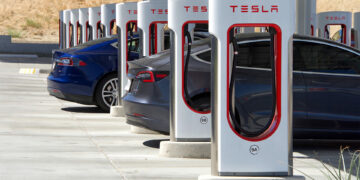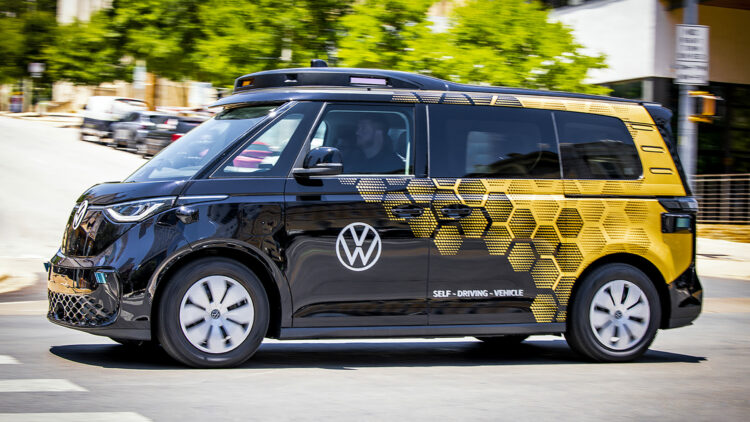Volkswagen is setting a new benchmark in the evolution of autonomous driving technologies by spearheading the development of an autonomous Level 4 service vehicle, a first of its kind for large-scale production. This groundbreaking venture aims to revolutionize mobility and transport services across Europe and the USA, leveraging high synergies with automated driving systems within the Volkswagen Group, facilitating module sharing from Level 2+ to Level 4.
The German automaker has announced a partnership with the Israeli tech giant, Mobileye Global Inc., to outfit the near-production prototype of the Volkswagen ID.Buzz with cutting-edge self-driving capabilities. This collaboration heralds the advent of autonomous driving following rigorous road testing in Germany and the USA. Under this agreement, Mobileye will provide software, hardware components, and digital maps to power the self-driving ID. Buzz, an initiative that has been under development since 2021.
The vehicle's self-driving system (SDS) aligns with the Society of Automotive Engineers (SAE) Level 4 autonomy, enabling it to operate independently within specified urban areas. Equipped with an array of sophisticated technologies, including dual high-performance computers, 13 cameras, nine LiDAR, and five radar units, the ID. Buzz can generate a comprehensive 360-degree view of its surroundings. Constant online connectivity allows the vehicle to access swarm data from other road users, updating its three-dimensional maps to ensure safe, efficient, and reliable navigation.
Christian Senger, a Board of Management member at Volkswagen Commercial Vehicles overseeing Autonomous Driving, Mobility, and Transport, highlighted the significance of strong partnerships in bringing autonomous shuttles to the roads at scale. He remarked, “We are developing the first fully autonomous large-scale production vehicle, using Mobileye’s digital driver.” This venture benefits from the synergies of automated driving systems across the Volkswagen group, allowing for cost reductions and scalability by sharing modules across various levels of autonomy.
The Volkswagen Autonomous Driving and Mobility Technologies (ADMT) division is not just about pioneering intelligent vehicles but also about crafting the software technologies that underpin these fleets. This includes sophisticated fleet management systems, with MOIA, Volkswagen's group company, contributing its extensive experience from operating Europe's largest private ride-pooling service in Hamburg since 2019. After announcing a ‘Hard Reset' of its entire software division last May, VW is keen to push forward as fast as possible.
Beyond passenger transport, autonomous vehicles hold significant potential for the logistics sector, especially given the industry's growth fuelled by e-commerce and the concurrent challenges posed by driver shortages. Autonomous delivery services could offer a sustainable solution to these issues, allowing for continuous delivery capabilities. Volkswagen ADMT is actively exploring autonomous freight transport for various industries, envisioning a future where vehicles independently navigate to loading stations or customer addresses.
As cities face the dual challenges of driver shortages and the need for improved mobility solutions, autonomous vehicles offer a promising solution. Robo-shuttles not only enhance urban living standards but also contribute to economic development, showcasing Volkswagen's commitment to innovating mobility for the future.
In case you're not certain about the various levels of Autonomous Driving, you can read our in-depth article here – or skim over this quick overview. The development of autonomous vehicles is categorized into five levels by the Society of Automotive Engineers (SAE), ranging from Level 1 (minimal automation) to Level 5 (full automation):
- Level 1 (Driver Assistance): Vehicles at this stage can control either steering or acceleration/deceleration with systems like cruise control or lane-keeping assistance. However, human drivers are required to manage the other functions and remain engaged with the driving process
- Level 2 (Partial Automation): At this level, vehicles can simultaneously manage steering and acceleration/deceleration but still require the driver to be attentive and ready to take control at any moment
- Level 3 (Conditional Automation): Vehicles have the capability to handle all driving tasks under certain conditions, but human intervention is required when the system requests it
- Level 4 (High Automation): Vehicles can operate independently in specific conditions or areas without any human intervention, which is the level that the Volkswagen ID.Buzz AD is being aimed at
- Level 5 (Full Automation): At this ultimate level, vehicles can perform all driving operations under all conditions without the need for a human driver
Volkswagen's foray into Level 4 autonomous driving with the ID.Buzz marks a significant milestone for the German auto maker, promising to help reshape the future of mobility and transport services on a global scale.
More importantly, when a critical mass of major car companies is ready to provide autonomous driving models, the EU and various other governments will be forced into agreeing a framework/set of rules under which Autonomous Driving will be allowed to happen ‘at scale'.
Europe has been making strides towards establishing a framework for autonomous driving, yet a fully harmonised global agreement remains ‘in development'. The European Union (EU) has been pivotal in driving regulatory updates to accommodate autonomous vehicle technologies, aiming for harmonisation across member states. This includes adapting the Vienna Convention on Road Traffic to accommodate non-human drivers, a crucial step for legalising autonomous vehicles.
The EU's strategy aims to position Europe as a leader in connected and automated mobility (CAM), covering safety, liability, data protection, and infrastructure. However, creating a global framework requires aligning diverse regulations across countries, a complex task given varying legal and technological landscapes.
The United Nations Economic Commission for Europe (UNECE) facilitates international agreements for vehicle regulations, essential for autonomous vehicle standardisation. Despite challenges, efforts are ongoing to unify regulations, potentially paving the way for a global framework for autonomous vehicles.
Given how much Chinese EV makers want to expand into Europe, it's almost certain that any EU framework agreement will also be adopted/adapted by China. Once the Chinese and European markets are aligned – it would be difficult for the US etc to opt for hugely different rules, if they have any ambitions about selling into a (combined) market of 1.4 billion consumers.


















Discussion about this post